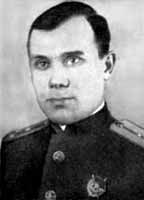Soviet Union

Starshiy Leitenant Nikifor Ignat'yevich Ignat'yev
Soviet Union

Starshiy Leitenant Nikifor Ignat'yevich Ignat'yev

1 June 1915 - 3 December 1943
Nikifor Ignat’yev was born on 1 June 1915.
He joined the Red Army on 27 May 1937 and graduated from the military aviation school in August 1940.
From 24 March until December 1941, he served in 3./71 IAP-KBF, which was equipped with Polikarpov I-153s.
In March 1942, he was transferred to the 27 IAP-SF (North Sea Fleet Air Force).
In April 1942, his unit was still equipped with the old I-153 Chaika biplanes in low-level attacks against the German troops at Motovskiy Bay.
The port of Murmansk was attacked twice on 15 April by Ju 87s of I./StG 5, escorted by Bf 110s of 10.(Z)/JG 5 and Bf 109E/Fs of II./JG 5. The 5712-ton British transport vessel Lancaster Castle was sunk by the Stukas during the attacks, the vessel suffering a direct hit to its engine room. A railway crane, a drydock and a warehouse were also destroyed in the port itself, while the canteen building caught fire and three railway tracks were severed. A 500-kg bomb fell into a bomb shelter, and although it failed to explode, the building collapsed, killing 21 and injuring eight.
The first raid came at 14:05 and it met negligible opposition. The Luftwaffe fighters brushed aside the handful of I-16s and I-153s without difficulty and claimed one enemy fighter destroyed (reported as an I-180), when Feldwebel Theodor Weissenberger of 10.(Z)/JG 5 claimed one at 13:18, 10 km west of Murmansk.
The second raid, at 18:30, met stiffer opposition, with ten Hurricanes and three MiG-3s of 2 GIAP-SF being scrambled to intercept the raiders. Leading the defenders was kapitan Alexander Kovalenko, whose formation was accompanied by nine 78 IAP-SF Hurricanes led by starshiy leitenant Petr Sgibnev, as well as by a flight of I-153s from 27 IAP-SF. Six Hurricanes of 122nd IAD’s 769 IAP also joined in.
16 Stukas, flying in pairs and with a close escort of Bf 110s, approached the target from a height of 3,500 m. Behind them, spaced at intervals of 500-1000 m and some 500 m higher, came nine Bf 109s. The dive-bombers wheeled around in a 90-degree turn before diving steeply out of the sun one after another. They were accompanied down to 200 m by their close escort, while the Bf 109s kept their distance.
The Guards pilots took off in line astern after receiving word of the approaching German formation, with kapitan Kovalenko in front. He was ordered to head to Murmansk at a height of 3,500.
There were only three aircraft in the circuit at that time, and without waiting for the others to join up, Kovalenko led them towards the threatened city. While flying at an altitude of 2,500 m, he sighted the enemy aircraft above him, but he considered an attack with just three fighters into the sun unfeasible. Kovalenko duly manoeuvred his small force in behind the bombers while the rest of the Hurricanes and MiG-3s joined him. As the Stukas commenced their diving attack the Hurricane pilots fired a salvo of rockets into the middle of the enemy formation from a range of 400 m, before splitting up and making individual attacks. Kovalenko opened fire from a range of 200 m, and he continued to fire until he was just ten metres behind his target. He was later to report ”the Ju 87 turned over and the cockpit canopy flew off”. Kovalenko did not have time to see his victim hit the ground as he was attacking a second enemy bomber. Opening fire at 100 m, he watched the Stuka roll over onto its back and tumble earthwards. Again, he was too busy to witness its final demise as by then the Bf 109s had arrived on the scene. In the end, it seems that Kovalenko only was credited with one Ju 87 shot down in this combat. Upon their return to base starshiy leitenant Pavel Orlov and starshiy leitenant Sergei Kurzenkov also claimed to have destroyed a Ju 87 apiece, the former reporting:
“At an altitude of 1500 m and from a range of 250-270 m I opened fire on the Ju 87’s engine from behind. The engine was engulfed in smoke and I unleashed a second salvo from above and behind while inverted as the Ju 87 was pulling out of its dive. The aircraft caught fire and there were two tongues of flame coming out of each side of the fuselage. I then gave the dive-bomber another burst. It slowed and went down.”Orlov overshot the Ju 87, and after making a tight banking turn and scanning the sky, he was unable to locate his adversary. Kurzenkov’s report was even briefer:
“I attacked one Ju 87 when it was pulling out of its dive, opening fire from a range of 100 m. After the third burst of machine gun fire the Ju 87 crashed 5-8 km west of Murmansk.”A fifth Ju 87 was claimed by 2 GIAP-SF when one was claimed by Husin Abishev.
For this combat, Ignat’yev was awarded the Order of the Red Banner on 26 May 1942.
In the evening on 29 April, 6./JG5 managed to catch the obsolescent I-153s in the air near Zapadnaya Litsa. In the uneven combat that followed, three biplanes were shot down (one by Unteroffizier Rudolf Müller (totally 92 victories)). Serzhant Kozshevnikov was killed while both starshiy leitenant Ivan Afanasenkov and starshiy leitenant Ignat’yev survived; Ignat’yev with injuries in his leg. Under fire from German troops which again hit his wounded leg, Ignat’yev crawled from his crash-landed I-153 in no-man’s-land back to the Soviet lines. There he reported the “taran” of a Bf 109.
Starshiy leitenant Afanasenkov was shot down in flames and suffered burns, which sent him to hospital. It’s possible that Afanasenkov also claimed one Bf 109 in this combat since it’s known that he claimed one during the day.
For this combat, Ignat’yev was awarded a second Order of the Red Banner on 4 July 1943.
He left 27 IAP-SF after this combat and upon recovery, he was posted to 78 IAP-SF in March 1943.
At 11:52 on 29 April 1943, starshiy leitenant Ignat’yev shot down a Bf 109G-2 in the Murmansk area.
The German fighter was flown by Feldwebel E. Fahldieck of 6./JG 5, who was captured and became a PoW.
Ignat’yev was killed on 3 December 1943 in battle near Polyarniy (Murmansk region).
At the time of his death Ignat’yev was credited with 3 biplane victories and a total of 5.
He had made more than 300 sorties and also destroyed one field-gun, eight anti-aircraft machine-guns and one aerial observation balloon.
He was decorated with the Order of the Red Banner three times.
Claims:
| Kill no. | Date | Time | Number | Type | Result | Plane type | Serial no. | Locality | Unit |
| 1942 | |||||||||
| 1 | 15/04/42 | 1 | Bf 110 (a) | Destroyed | I-153 | Murmansk area | 27 IAP-SF | ||
| 2 | 15/04/42 | 1 | Ju 87 | Destroyed | I-153 | Murmansk area | 27 IAP-SF | ||
| 3 | 29/04/42 | evening | 1 | Bf 109 (b) | Destroyed | I-153 | near Zapadnaya Litsa | 27 IAP-SF | |
| 1943 | |||||||||
| 4 | 27/03/43 | 1 | Bf 109 | Destroyed | Hurricane | SW Murmansk | 78 IAP-SF | ||
| 5 | 29/04/43 | 11:52 | 1 | Bf 109 (c) | Destroyed | Hurricane | Murmansk area | 78 IAP-SF | |
| 24/05/43 | 1 | Bf 109 | Presumably destroyed | Hurricane | Cape Pikshuev | 78 IAP-SF |
Biplane victories: 3 destroyed.
TOTAL: 5 and 1 presumably destroyed.
(a) Claimed in combat with Bf 110s from 10.(Z)/JG 5.
(b) Claimed in a “taran” attack in combat with 6./JG5.
(c) Bf 109G-2 flown by Feldwebel E. Fahldieck of 6./JG 5, who was captured and became a PoW.
Sources:
Aeroram
All aces of Stalin 1936–1953 – Mikhail Bykov, 2014
Black Cross/Red Star Volume I - Christer Bergström and Andrey Mikhailov, 2000 Pacifica Military History, ISBN 0-935553-48-7
Black Cross/Red Star Volume II - Christer Bergström and Andrey Mikhailov, 2001 Pacifica Military History, ISBN 0-935553-51-7
Soviet Aces 1936-1953
Soviet Hurricane Aces of World War 2 – Yuriy Rybin, 2012 Osprey Publishing Limited, Oxford, ISBN 978-1-84908-741-1
Soviet Fighter Pilots 1936-1953 - Mikhail Bykov
Stalin's Eagles - Hans D. Seidl, 1998 Schiffer Publishing, ISBN 0-7643-0476-3
Additional information kindly provided by Ondrej Repka and Yuri Shakhov.


